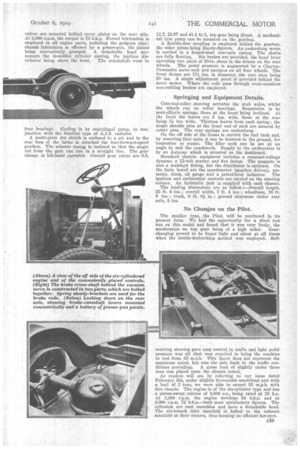A PARTNER FOR THE PILOT
Page 56

Page 57

If you've noticed an error in this article please click here to report it so we can fix it.
The New A.J.S. Commodore Chassis for 32-seater Bodies has a Six-cylindered Engine and Forward Control. Its Design Follows Closely that of the Pilot Model.
TN the earlier part of the present year, A. J. Stevens and
(1914), Ltd., Walsall Street, Wolverhampton, made its bow as a commercial-vehicle manufacturer. The first model put upon the market was, of course, the Pilot chassis, for bodies accommodating 24 or 26 passengers. Having thoroughly tried out this type the company has now, in addition, decided to offer a larger model. This newcomer is the Commodore, which is designed for 32-seater bodies, and in many respects it follows the lines of the forwardcontrol Pilot.
A Loading Height Below 2 ft.
A low loading-level is one of the features of the design; its height, when laden, is 1 ft. 111 ins. Behind the dash the main frame-members are swept downward and continue at the height named, except for the upswept portion over the rear axle. The steel used is in. thick, and the maximum depth is 10 ins. Six cross-members are used ; one carries the radiator, another suppons the front of the engine-gearbox unit, whilst one of the remaining four supports the steady bearing of the twopiece propeller shaft. This bearing is carried in a housing. Engine mounting is of the three-point variety ; a trunnion surrounds a boss ou the front of the crankcase, whilst arms on the clutch pit rest upon brackets on the frame.
The R.A.C. rating of the power unit is 36 b.p. and the bore and stroke are n ins. by 5 ins. respectively. The valves are mounted behind cover plates on the near side. At 2,000 r.p.m. the output is 75 b.h.p. Forced lubrication is employed to all engine parts, including the gudgeon pins; chassis lubrication is effected by a grease-gun, the points being conveniently grouped. A detachable head surmounts the monobloc cylinder casting, the ignition dis tributor being above the bead. The crankshaft runs in four bearings. Cooling is by centrifugal' pump, in conjunction with the familiar type of A.J.S. radiator.
A multi-plate dry clutch is enclosed in a pit and to the rear face of the latter is attached the four-forward-speed gearbox. The selector casing is inclined so that the single rod from the gate can run in a straight line. The gear change is left-hand operated. Overall gear ratios are 6.5, 11.7, 21.97 and 41,4 to 1, top gear being direct. A mechanical tyre pump can be mounted on the gearbox.
A flexible-disc coupling is employed behind the gearbox, the other joints being Hardy-Spicers. An underslung worm is carried in a forged-steel rear-axle easing. The shafts are fully floating. Six brakes are provided, the hand lever operating two pairs of 20-in, shoes in the drums on the rear wheels. The pedal pressure is augmented by a ClaytonDewandre servo unit and operates on all four wheels. The front drums are 17i ins, in diameter, the rear ones being 20 ins. A single adjustment point is provided behind the servo motor. Where the rods pass through cross-members non-rattling bushes are employed.
Springing and Equipment Details.
Cam-and-roller steering actuates the stub axles, whilst the wheels run on roller bearings. Suspension is by semi-elliptic springs, those at the front being inclined. At the front the leaves are 3 ins, wide, those at the rear being 3i ins. wide. Thirteen leaves form each spring; the single shackle pins at the front end of each are secured by cotter pins. The rear springs are underslung.
On the off side of the frame is carried the fuel tank and, by removing four nuts, it can be lowered to the ground, for inspection or repair. The filler neck can he set at an angle to suit the coachwork. Supply to the carburetter is by an Autovae which is situated on the dashboard.
Standard electric equipment includes a constant-voltage dynamo, a 12-volt starter and five lamps. The magneto is also a standard fitting, but the distributor is optional. On the facia board are the speedometer (gearbox driven), ammeter, clock, oil gauge and a petrol-level indicator. The ignition and carburetter controls are carried on the steering column. An hydraulic jack is supplied with each chassis.
The leading dimensions are as follow :—Overall length, 25 ft. 4 ins.; overall width, 7 ft. 4 ins.; wheelbase, 16 ft. 6 ins.; track, 6 ft. 01 in.; ground clearance under rear axle, 8 ins.
No Changes on the Pilot.
The smaller type, the Pilot, will be continued in its present form. We had the opportunity for a short test run on this model and found that it was very lively, the acceleration on top gear being of a high order. Gear. changing proved to be finger light and silent at all times -when the double-declutching method was employed. Self centring steering gave easy control in traffic and light pedal pressure was all that was required to bring the machine to rest from 50 m.p.h. This figure does not represent the maximum speed, but was the safe limit in the traffic conditions prevailing. A gross load of slightly under three tons was placed upon the chassis tested.
As readers will see by referring to our issue dated February 5th, under slightly favourable conditions and with a load of 2 tons, we were able to exceed 55 m.p.h. with this chassis. The engine is of the six-cylinder type and has a piston-swept volume of 3,800 c.c., being rated at 25 h.p. At 2,000 r.p.m. the engine develops 54 b.h.p. and at 3,000 r.p.m. 72 b.h.p.—both most satisfactory figures. The cylinders are rest monobloc and have a detachable head. The six-branch inlet manifold is bolted to the exhaust manifold at their centres, thus forming an efficient hot-spot.




























































































































